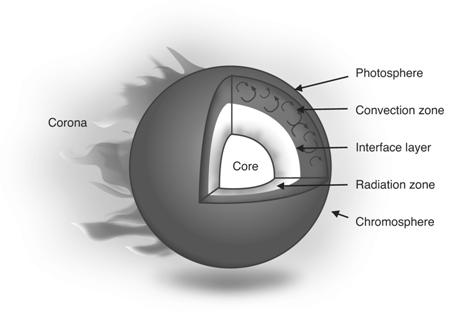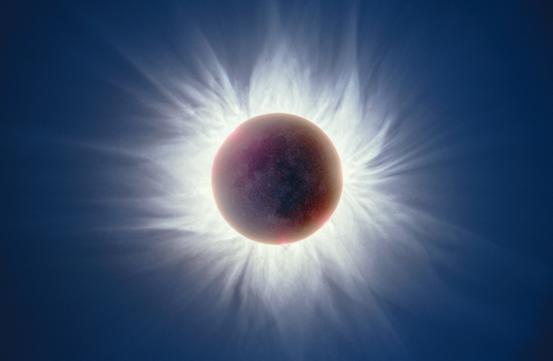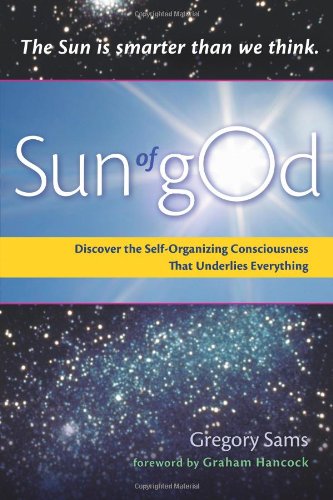We are pleased and honored to welcome Gregory Sams as our September 2009 Author of the Month here at grahamhancock.com. Author, health food pioneer and cultural change agent, Gregory Sams' first book 'Uncommon Sense, the State is Out of Date', took chaos theory into a socio-political context. Now, he brings you 'Sun of God', the culmination of 7 years of focus on the subject of solar sentience and its relevance to you, me and everything in creation.
Imagine living in a culture where people spent more time deciding what brand, colour and flavour condom to buy, than they do to considering prospective candidates and the act of sex itself. Something would be out of balance. Yet we live in a culture where most people will have spent more time in their lives contemplating which style of sunglasses to purchase than they will have spent contemplating the most important thing in those lives, the Sun itself. Something is out of balance.
It was once absolutely common to give the Sun a great deal of thought, respect and appreciation. Many of the greatest monuments that survive from ancient civilizations were built to honour the Sun. Yet we are raised with the built-in assumption that ancient people were primitive and uncivilized savages. As modern researchers such as Graham Hancock and Michael Cremo have clearly shown, nothing could be further from the truth. Though in many ways we now enjoy an advanced technology to that that which existed thousands of years ago, it is not so certain that our understanding of the cosmos and our spiritual development have advanced at the same pace.
Many modern researchers have explored what remains of the civilization of ancient Egypt, recognizing the cosmological alignment of ancient pyramids and calculating where their shafts would have originally pointed towards in the night sky. Others have studied the Mayan calendar and been amazed at the understanding it displays of solar and stellar activities taking place tens of thousands of years prior. Tens of thousands make the pilgrimage to Stonehenge every summer solstice to touch and absorb the energy of the hallowed stones of this Celtic monument. We acknowledge our social and scientific debt to the ancient Greeks, whose rediscovered knowledge helped fuel the Renaissance and lift Europe out of the Dark Ages.
Yet as we explore the history of these cultures, we all too easily overlook the one underlying principle common to the Egyptians, Maya, Celts and Greeks, not to mention the Sumerians, the Chaldeans, the Assyrians, the Gnostics, the Khmer, the Norse, the Inca, the Aztec, the natives of South and North America and countless other cultures through the world, including today's Hindu and Shinto religions. This is the recognition that our local star is a conscious entity – a celestial being. It remains one of the most powerful and unspoken taboos of the Western world and one which even modern researchers of the above cultures are often reluctant to breach.
Many of us have finally let go of the Biblical mindset that placed humans on planet Earth as the be all, end all, and raison d'etre of God and the Universe. Since 1975 we have been seeking other intelligences across the galaxy, looking for telltale radio signals, incorporating technology that enlists the brainpower of idle computers throughout the world. Though I quietly came to the realization that there was intelligence in residence at our local star in 1966, I only really "came out" on the subject when the subject of SETI came up. I would feel compelled to point out that this "Search for Extra-Terrestrial Intelligence" was being conducted in complete ignorance of the most intelligent character in the neighbourhood – our local star. And none of those special tools or techniques is required to spot this one – just an open mind that has let go of an old taboo. It should really be called SSLU – the Search for Something Like Us.
Our culture is infused with the notion that the "sun worship" once practiced throughout the world was born out of ignorance. When SETI got me going on the subject, I would often get "are you kidding?" and "who is this crazy man?" looks – just the sort of looks that my brother and I received in the 1960's when introducing people in Britain to the radical freaky notion that what we ate affected our health and well-being. This unfounded assumption came up recently on a Sunday morning spiritual radio programme when I was asked "But they were just primitive then – don't we know better now?" That is an interesting question and I must reply with a question "Is there anything we know today, from the latest in solar science and astronomy, to physics and quantum mechanics, that has any bearing on the issue of solar consciousness?"
We will return to that question later, but first must ask what we know about our own consciousness that would assist us in the evaluation of whether such a phenomenon could be existing elsewhere, whether in bacteria or thousand year-old trees, volcanoes or stars?
What is this stuff that we are forever talking about raising or lowering? What is this quality that distinguishes our complex body with being alive and vital?
What do we know…. about this?
We know that many scientists actually doubt its existence. Since they have no tools with which to weigh it or measure it, and there seems to be no formula that can express consciousness, this group finds no alternative but to deny its existence. They believe consciousness to be an illusion that is constructed by our brain to gain some, as yet undetermined, evolutionary advantage. Some of this "Grand Illusion" camp has a corollary to their belief, which is that human beings have no free will – that every single thing we do or think (every rhyme, each wink and stink) was somehow pre-determined by the arrangement of particles immediately after the Big Bang.
For scientists who do acknowledge the existence of consciousness it was assumed, until very recently, that human beings were the only vessel that it could possibly inhabit. Nothing else was deemed to be aware of its own existence, or functioning on anything other than the level of a biological machine driven by nothing more than the need to propagate the species. Descartes had a lot to do with this, but now there is debate going on, as some scientists devise tests for consciousness, such as recognizing your self in the mirror, or playing for no apparent reason other than to have fun. This camp is arguing that orang-utans and dolphins and a handful of other species, mainly primates, might just share this rare facility.
But scientists are not getting very far, perhaps not trying very hard, in understanding what consciousness is or from whence it arises. And that isn't surprising, considering what a tricky word it is to define – right up there with "God" and "infinity". There is no accepted standard definition for consciousness. Mystics and philosophers have devoted entire books to it or summed it up with the two words "consciousness is."
Without the need for proof or measurement, we know of our own consciousness because we feel its existence. It was enough for ancient civilizations to know of solar consciousness because they felt its existence. I do not suggest that because we "feel" something it is true. But when a near universal belief is sustained for thousands of years it merits consideration. It does not matter which continent we look at, or which century, or which culture. Our pre-Christian ancestors believed that their basic intuition was correct, notwithstanding any explanations and baggage that might thereafter have been added to the picture by organizing priests.
We might well experience this connection to solar consciousness intuitively when, as children, we put smiling faces upon drawings of the Sun. But by the time we leave school there is little hint of it left, as we adopt the "We know better now" attitude. Which brings us back to that question of just what it is that we now know better. And who were the original "we" that we know better than? Is it science that has taught us that Sun worship was primitive and irrational?
Were you to have told a Mayan or Egyptian Sun worshipper of the fusion reaction in the core of the Sun, describing the very different functions of the next six layers, explaining the corona and the solar wind that spins from it, their jaw would have dropped in delighted awe. Our science would give them greater cause to revere the character bringing light and the power of life to our world. The knowledge of anatomy does not diminish our living status.
Was it the church that told us Sun worship was primitive and irrational? Yes. They knew better because the Old Testament told them so. They had it on God's authority, written in His own book, that the Sun was just a convenient ball of light placed in the Heavens for the benefit of humankind. And since most of the religions which had been replaced by the new church were big on Sun worship it was very much not ok to persist with such ideas. Neither philosophers, scientists nor variants of Christianity were excluded from Papal control of such thinking.
The Christianity of the Cathars, influenced by Mary Magdalene's transmission of Christ's teachings, incorporated sun gazing and elements of solar appreciation into its practice. This, and other unauthorized deviations from Catholic creed prompted the Vatican to organize 20 years of the brutal Albigensian Crusade (1209-1229) and to create the dreaded Inquisition, dedicated to eliminating every last trace of the Cathars religion and its followers.
Nearly four centuries later, in 1593, they were again alarmed, this time by the teachings of one Giordano Bruno. Copernicus who came before, and Galileo who came later, recognized that the Sun and planets did not revolve around Earth, believing instead that the whole Universe revolved around the Sun. Unlike them, Bruno also recognized that our Sun was but one of countless stars populating an infinite Universe. He also recognized that the Sun and stars were all living beings – still something of a blind spot for modern astronomers. He was lured back to Italy, arrested by the Inquisition and imprisoned for 7 years during which time he refused to recant, even under torture. When finally sentenced to death he responded to the judges: "Perhaps you, my judges, pronounce this sentence upon me with greater fear than I who receive it." His tongue was tied before he was tied to the stake, lest he try to spread his inflammatory ideas to the assembled crowd.
The scientific aversion to considering the question of solar consciousness, in essence, stems not from solar experimentation, technical investigation, or application of the scientific method. It stems from little more than habit, and a religious habit at that.
Obviously, we are not going to be able to apply our normal consciousness tests to the Sun, with mirrors, questionnaires, and analysis of playfulness. But we can take a look at what solar scientists have been able to find using telescopes, helioseismology, spectral analysis, and some pretty brilliant thinking and deduction. I am not in the business of knocking scientists or their discovery, but I am intolerant of the unfounded taboos that most of them embrace, and to which all of them must conform, or face ridicule.
Let us take a very cursory look at a few features of the Sun's seven distinct levels, to see if these are the sort of features you would expect to find in an inanimate, unintelligent, accidental agglomeration of simple matter. And the Sun's matter, in common with 99%+ of matter in the Universe, is not in the "simple" states of solid, liquid or gas with which we are familiar on this planet. Most matter does not have an even balance of electrons and protons and is thus highly fluid and conductive to the transmission of electro-magnetic energy. Plasma is very active. It almost looks like it is a living thing in those plasma gas balls that are sold for visual home entertainment.

The hot inner core is where the nuclear fusion reaction takes place, converting 5 million tons of the Sun's mass into energy each second. This reaction has been going on steadily for some 4.5 billion years and is estimated to have at least as long a future. With the equivalent of billions of hydrogen bombs going off every second, some containment around this first layer of the Sun is obviously necessary. This second level takes the form of the radiation zone, a region of very dense matter that is 25 times as thick as the Earth's diameter. Travelling at the speed of light, a photon would pass through this layer of the Sun in about one second, but they have to bounce around a bit on the journey outwards and it takes them more like a million years to make the transit. Photons enter this zone as deadly gamma rays vibrating at high frequency and low wavelength, exiting it as safe visible light – the stuff that reaches our planet and sustains all life.
Outside the radiation zone is the third, and relatively thin, interface layer, described as being like giant twisting ropes of electro-magnetic energy. It is thought to be here that electromagnetic energy is produced to power the Sun's invisible outermost seventh layer, the corona – about which more later. This energy is believed to be generated by the differential rotation of the convection zone, which surrounds the radiation zone and turns at a different speed, producing a dynamo-like effect.
Huge bubbles of charged matter carry the photons from the core through the convection zone to the photosphere with a fractal turbulence compared to that of water in a fast boiling kettle. Whilst the density of the plasma at the beginning of the radiation zone is that of gold, by the time we reach the convection zone the density is that of water. It will emerge into the next level in about a week, where the density of the Sun is now far thinner that the Earth's outer atmosphere.
At just 100 -300 km deep, the visible outer surface of the Sun is relatively as thin as an onion skin. The photosphere provides the setting or base for many of the Sun's most visible, intriguing and dramatic features, from sunspots to solar flares, coronal mass ejections to coronal prominences. Isaac Newton was the first to spot sunspots and track their activity. Records have been kept ever since of their cyclical, though inconsistent nature. Solar scientists are still as puzzled as was Newton by their meaning and mechanism, but have noticed enough of a correspondence with coronal activity to believe that they are managed or controlled by the corona. The same is thought to be the case with flares, coronal mass ejections and prominences, each of them fascinating and powerful events that defy any straightforward explanation.
We have rushed through the processes taking place in the five inner layers of the Sun, in order to give more space to the energetic outer level. We have burst forth from the light-producing core and bumbled through the light-processing radiation zone, twisted through the electrical interface layer, bubbled through the seething convection zone and shot out of the photosphere, adding another spark to the Universe. We have not reached the outer levels of the Sun, but already it seems curious to believe that such structured, complex, co-ordinated and sustained activity is all going on by accident with nary a drop of intelligence involved. Were solar scientists to step outside the bounds of their religiously rooted taboo I strongly suspect that they would recognize this complex and energy-rich assembly of active plasma to be another life form to ours, and quite probably a higher one at that.
The temperature of the Sun progressively drops as photons travel from a 15 million degree core to the 5800 degree photosphere. We would expect the temperature to drop even further as we travel outwards from the surface into the coldness of space. But instead the temperature rises – one of many unexplained aspects of solar behaviour. The "atmosphere" of the Sun is so thin in matter content that it would be considered a near vacuum by our standards, but it is rich in energy and activity.
The lower level of Sun's atmosphere, the chromosphere, is populated by what look like long thin needles or jets of red light shooting upward at high speed. First spotted in 1851, they are called spicules, and there have been various theories as to what they are. The big bubbles of the convection zone may be sending sound waves into the chromosphere powering their upward trajectory at supersonic speeds. One must wonder about the purpose of this activity in the system of a living Sun. At the top of the irregular chromosphere the temperature has jumped from 5800 to 20,000 degrees, and at the other end of the wafer-thin transition to the outer atmosphere, the heat runs to a million degrees.
Now we reach the least understood feature of Sun and, perhaps, its crowning glory. The energy-rich and matter-light corona is bigger than Sun's physical "body," stretching two or three million kilometres into space. Temperatures have become hundreds of times hotter, ranging from one to five million degrees K. Why hasn't the heat emanating from Sun's surface just dissipated into the cold surrounding space? Scientists still struggle to understand why this is.
The corona is an invisible electro-magnetic phenomenon, but the power of its activity and associated events are awesome. It only manifests during a total solar eclipse, as even 1% of Sun's light will completely overwhelm that of its corona. What we see at this moment is its eponymous crown-like shape outlined by light released by free electrons streaming off the Sun, excited by the corona's powerful magnetic field lines. Its shape is not constant, changing along with the Sunspot cycle on the photosphere. Whilst solar scientists hold it responsible for many of the Sun's features, they describe the corona as the most mysterious feature of the Sun. Interesting.
Whilst scientists grapple with the very real difficulties of explaining the nature and existence of the Sun's corona, permit me to hypothesize about the possible relevance of this fascinating phenomenon. Perhaps the invisible corona is the most important feature of Sun – that to which all else is geared, and that which is responsible for some of its most far-reaching effects. It is difficult to resist the temptation to compare aspects of a living conscious Sun to our own existence, relating its fusion-reactor core to our own heart or its chromosphere full of spicules to our seeing apparatus. But it is, of course, a completely different nature of being and in some respects one might as well be looking for the nose of a cauliflower or the nipples of a trout.

It does seem reasonable, though, to look for the mind of a conscious Sun and here, I suggest, one need look no further than its corona. Like our own mind, the corona is essentially an invisible extension of the Sun. As with the force lines of a magnet, all we can ever see is the effect of the corona upon particles that are in its presence. Some scientists will no doubt continue to debate the existence of a human mind until tools are developed sensitive enough to register and measure it. In the perfect darkness of a total solar eclipse, does it not seem likely that we are witnessing the image of a mind infinitely more powerful than our own – without the need for any special tools?
We will leave the Sun now, hitching a ride out on the solar wind, a rarefied stream of charged particles that spins from the corona at speeds of 300-900 kilometres per second. As the Sun turns, the solar wind twists into a huge spiralling electro-magnetic bubble called the heliosphere, which holds the entire solar system in its embrace, cushioning its planets from the potentially disruptive effects of cosmic rays. Isn't that thoughtful?
Recognition of the Sun and other stars as living beings changes the way we look at everything, not just galaxies and a Universe awash with them, but at all else down to subatomic particles and up to light itself. Could there be similarities on different scales between the 100-billion+ neurons in own brains and the 100-billion+ stars in our galaxy, all of them sending electromagnetic signals in the direction of their neighbours? How do molecules of water become a thundercloud hurling bolts of lightning earthwards? Can a tree be tickled by the ripple of a breeze; an ocean know its currents' flow; a mountain feel its majesty? How could clouds of hydrogen and helium atoms assemble into something as complex and finely tuned as a light-producing star?
Could energy have been the original raw material of matter, and is it energy that holds it all together – is it, too, the architect? For us, it is energy that provides the spirit of life. Without energy we do not live or think. Without energy there is nothing that we call living left. Yet we are brought up with the assumption that it is us who brings the life to energy, and not the other way around.
Why do so many of our linguistic expressions for intelligence rely upon light-related words, using phrases and terms as we shed light on the matter, enabling us to see the light, after which we may be illuminated on the subject, in the light of the brilliant new insights gained from the dazzling ideas of the bright author of an article on enlightenment? Isn't it delightful.
Why are there so many questions? Perhaps it is because we are curious. An open and curious mind drove and directed me along the journey of seven years that was the writing of Sun of gOd. The solar path led in many directions, illuminating an unexpectedly coherent whole as the book progressed. Within its pages the dogma has been stripped from science and the faith removed from religion to reveal the compatibility of ancient beliefs with cutting edge science.
Relieved of its unfounded anti-spirit prejudice, science can help us to recognize a Universe that is designed from the bottom up, not the top down. This Universe is intelligent and well designed without needing an Intelligent Designer pulling all the strings behind the scenes. Sun of gOd underwrites the ancient wisdom of "All is One" in a refreshing and up-to-date manner, neither rejecting science nor relying on revelation to make the point.
Today's marvellous technology enables us to probe the far reaches of the Universe and to wonder on the mysteries of matter at a quantum level. Yet we have still to rediscover the most elemental aspect of our Sun, the most important character in our lives, even though no technology is required. Like us, it is alive. And the knowledge of that improves forever our relationship with the Universe.
Gregory Sams








